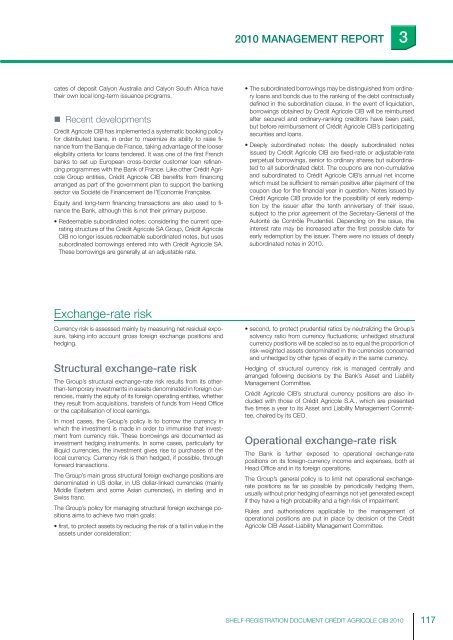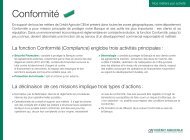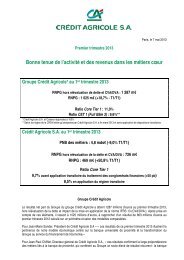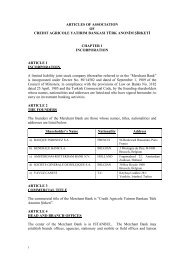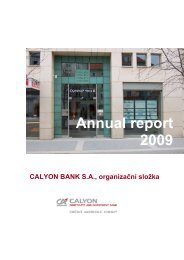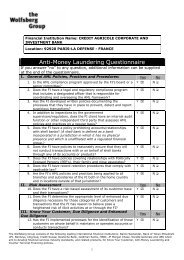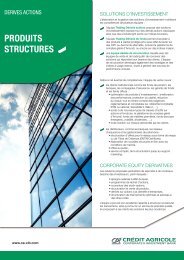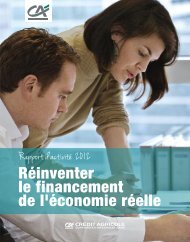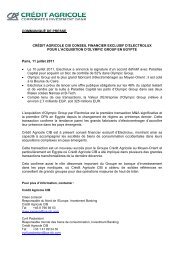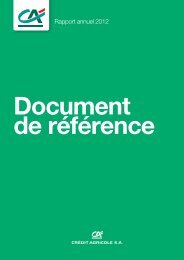ourexpertise - Crédit Agricole CIB
ourexpertise - Crédit Agricole CIB
ourexpertise - Crédit Agricole CIB
You also want an ePaper? Increase the reach of your titles
YUMPU automatically turns print PDFs into web optimized ePapers that Google loves.
2010 MANAGEMENT REPORT 3cates of deposit Calyon Australia and Calyon South Africa havetheir own local long-term issuance programs.• Recent developments<strong>Crédit</strong> <strong>Agricole</strong> <strong>CIB</strong> has implemented a systematic booking policyfor distributed loans, in order to maximize its ability to raise fi -nance from the Banque de France, taking advantage of the loosereligibility criteria for loans tendered. It was one of the fi rst Frenchbanks to set up European cross-border customer loan refi nancingprogrammes with the Bank of France. Like other <strong>Crédit</strong> <strong>Agricole</strong>Group entities, <strong>Crédit</strong> <strong>Agricole</strong> <strong>CIB</strong> benefi ts from fi nancingarranged as part of the government plan to support the bankingsector via Société de Financement de l’Economie Française.Equity and long-term fi nancing transactions are also used to fi -nance the Bank, although this is not their primary purpose.• Redeemable subordinated notes: considering the current operatingstructure of the <strong>Crédit</strong> <strong>Agricole</strong> SA Group, <strong>Crédit</strong> <strong>Agricole</strong><strong>CIB</strong> no longer issues redeemable subordinated notes, but usessubordinated borrowings entered into with <strong>Crédit</strong> <strong>Agricole</strong> SA.These borrowings are generally at an adjustable rate.• The subordinated borrowings may be distinguished from ordinaryloans and bonds due to the ranking of the debt contractuallydefi ned in the subordination clause. In the event of liquidation,borrowings obtained by <strong>Crédit</strong> <strong>Agricole</strong> <strong>CIB</strong> will be reimbursedafter secured and ordinary-ranking creditors have been paid,but before reimbursement of <strong>Crédit</strong> <strong>Agricole</strong> <strong>CIB</strong>’s participatingsecurities and loans.• Deeply subordinated notes: the deeply subordinated notesissued by <strong>Crédit</strong> <strong>Agricole</strong> <strong>CIB</strong> are fi xed-rate or adjustable-rateperpetual borrowings, senior to ordinary shares but subordinatedto all subordinated debt. The coupons are non-cumulativeand subordinated to <strong>Crédit</strong> <strong>Agricole</strong> <strong>CIB</strong>’s annual net incomewhich must be suffi cient to remain positive after payment of thecoupon due for the fi nancial year in question. Notes issued by<strong>Crédit</strong> <strong>Agricole</strong> <strong>CIB</strong> provide for the possibility of early redemptionby the issuer after the tenth anniversary of their issue,subject to the prior agreement of the Secretary-General of theAutorité de Contrôle Prudentiel. Depending on the issue, theinterest rate may be increased after the fi rst possible date forearly redemption by the issuer. There were no issues of deeplysubordinated notes in 2010.Exchange-rate riskCurrency risk is assessed mainly by measuring net residual exposure,taking into account gross foreign exchange positions andhedging.Structural exchange-rate riskThe Group’s structural exchange-rate risk results from its otherthan-temporaryinvestments in assets denominated in foreign currencies,mainly the equity of its foreign operating entities, whetherthey result from acquisitions, transfers of funds from Head Offi ceor the capitalisation of local earnings.In most cases, the Group’s policy is to borrow the currency inwhich the investment is made in order to immunise that investmentfrom currency risk. These borrowings are documented asinvestment hedging instruments. In some cases, particularly forilliquid currencies, the investment gives rise to purchases of thelocal currency. Currency risk is then hedged, if possible, throughforward transactions.The Group’s main gross structural foreign exchange positions aredenominated in US dollar, in US dollar-linked currencies (mainlyMiddle Eastern and some Asian currencies), in sterling and inSwiss franc.The Group’s policy for managing structural foreign exchange positionsaims to achieve two main goals:• fi rst, to protect assets by reducing the risk of a fall in value in theassets under consideration;• second, to protect prudential ratios by neutralizing the Group’ssolvency ratio from currency fl uctuations; unhedged structuralcurrency positions will be scaled so as to equal the proportion ofrisk-weighted assets denominated in the currencies concernedand unhedged by other types of equity in the same currency.Hedging of structural currency risk is managed centrally andarranged following decisions by the Bank’s Asset and LiabilityManagement Committee.<strong>Crédit</strong> <strong>Agricole</strong> <strong>CIB</strong>’s structural currency positions are also includedwith those of <strong>Crédit</strong> <strong>Agricole</strong> S.A., which are presentedfi ve times a year to its Asset and Liability Management Committee,chaired by its CEO.Operational exchange-rate riskThe Bank is further exposed to operational exchange-ratepositions on its foreign-currency income and expenses, both atHead Offi ce and in its foreign operations.The Group’s general policy is to limit net operational exchangeratepositions as far as possible by periodically hedging them,usually without prior hedging of earnings not yet generated exceptif they have a high probability and a high risk of impairment.Rules and authorisations applicable to the management ofoperational positions are put in place by decision of the <strong>Crédit</strong><strong>Agricole</strong> <strong>CIB</strong> Asset-Liability Management Committee.SHELF-REGISTRATION DOCUMENT CRÉDIT AGRICOLE <strong>CIB</strong> 2010 117


